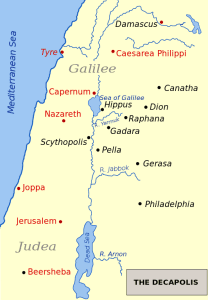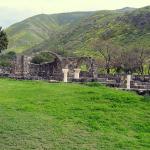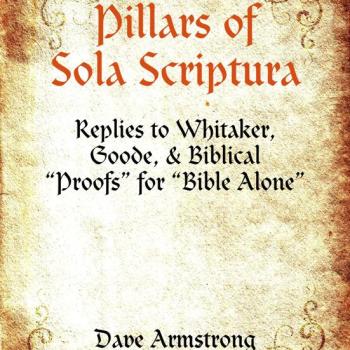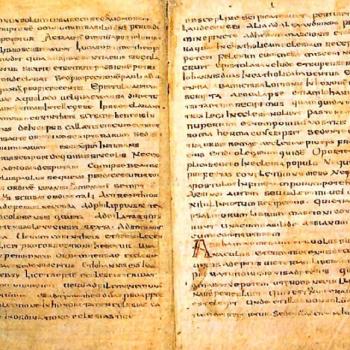Atheist anti-theist Jonathan M. S. Pearce is the main writer on the blog, A Tippling Philosopher. His “About” page from his former site states: “Pearce is a philosopher, author, blogger, public speaker and teacher from Hampshire in the UK. He specialises in philosophy of religion, but likes to turn his hand to science, psychology, politics and anything involved in investigating reality.”
He has encouraged me to visit his site and offer critiques. Before he departed his former site at Patheos, he wrote under a post dated 12-14-21: “I even need to thank the naysayers. Some of them have put up with a lot of robust pushback and still they come. Bravery or stupidity – it’s a fine line. But they are committed, and there is something to be said for taking that commitment into the lion’s den. Dave, you are welcome at my new place. Come challenge me. All the best to you and thanks for your critiques of my pieces. Sorry I couldn’t get to more of them.”
Again, at his new site (under a post dated 1-27-22), after a vicious attack by a commenter, calling for me and indeed all Christians to be banned, Jonathan offered an honorable and principled refusal: “I do welcome disagreements because I don’t want [my blog] to [be] just an echo chamber. As long as it is good faith . . . someone like Armstrong does give me ammunition for some of my pieces! As long as they aren’t trollish.”
Guest writer Lex Lata’s words will be in blue.
*****
“Lex Lata” has responded to my reply to his post, “You say ‘Gerasa’ and I say ‘Gadara’: The case of the “obviously and demonstrably false” place name in the Gospels” (2-16-22). Mine was entitled, Pearce’s Potshots #62: Gadarenes & Gerasenes #3 (2-17-22). He made his reply in the combox of his post (hosted on Jonathan MS Pearce’s site). My words that he cites from my previous article will be indented and in black. My present replies will be non-indented black. His words from his article (as opposed to his combox reply) will be indented and in blue.
There’s a lot going on there, and time being in short supply, I’ll just kinda do drive-by responses to some of the things that get my attention; definitely not everything.
Well, I hope that in due course you will get to “everything” because everything in my article is important to my overall argument, or else it wouldn’t be there in the first place. I like to make all my words and arguments “count.” Not much “filler” . . .
To quote the Dread Pirate Roberts/Wesley, “Get used to disappointment.” For my part, I think it’s unrealistic to expect folks to respond to everything I write, and it wouldn’t even occur to me to ask that much of them. Their time is theirs. They are welcome to read or respond to all or some or one or none of the points I might cover. [Lex shrugs.] And of course someone has to be quiet and let stuff go for a conversation to ever end.
***
I’ll note up front that we don’t disagree as much as you seem to think we do (yay!),
Yes, it is very good to agree and find common ground.
in part because you have an unfortunate and rather off-putting tendency to attribute positions to me that I don’t espouse (boo!).
If so, then that can be clarified as we dialogue. I don’t want to misrepresent anyone’s position. I’m not sure, however, that this relative “closeness” of viewpoint is the case with Jonathan, and in a way I was responding to this new dynamic duo of Jonathan + Lex [Jon-Ex or Lexathan?], since this is now my third reply on this topic and since he seemed quite jubilant about your article and quickly stated that “we” [i.e., you and him] would reply to anything I wrote in this regard and that my view was, in fact, already “destroyed.”
I don’t think you two are clones in your views, but forgive me if I sometimes miss the fine distinctions. The standard atheist view (and certainly Jonathan’s) is that the Bible massively, relentlessly contradicts itself. Recently, for example, we saw Jonathan arguing that Matthew simply made up the guards at the tomb story. For us Christians, that is very serious sin: lying, bearing false witness. I described that as making up fairy tales, and Jonathan construed that judgment as a personal attack on him (which it was not). If one has no evidence whatsoever for a claim, then that is accurately described as a fairy tale. But I digress . . .
This is a different argument than claiming a contradiction in a legitimate manuscript (i.e., in the actual Bible, as best we can determine it), as Jonathan and Lex do.
Nowhere do I make this claim. Rather, I write that human error (or conceivably a deliberate change) regarding the Gerasenes likely crept into the manuscript tradition at some point. Please see my final thoughts.
Well, with all due respect, I think you do so in the subtitle of your article, right out of the starting-gate: “The case of the ‘obviously and demonstrably false’ place name in the Gospels.” That (rather provocatively) is claiming that there is a falsehood in the Gospels; not in such-and-such manuscript[s]. And, quite obviously, as you unpack your argument, you are maintaining that there is an internal contradiction present, too. So I don’t see how you can characterize that as merely quibbling about manuscripts. The first time you mentioned “manuscript” it was in the context of the texts becoming canon:
Origen would have been less than ecstatic, then, to learn that the discrepancy he lamented came to nest securely in the manuscript tradition and become canon: [followed by your three NT citations]
Origen [just one man and with no particular authority, according to how Christians view the Church fathers] may have thought these were spurious texts, but in any event, they did enter the canon, and so it seems to me that that is how they must be discussed now: as part of the Bible, not merely a once-disputed manuscript which now no longer is. The alleged discrepancies you discuss are part of the canon now.
You only mention “manuscripts” one more time in your article: referring to Origen “collect[ing] important manuscripts.” This is hardly enough for any reader to get the impression that you were talking about disputed texts from different manuscripts, rather than disputed texts in the accepted NT canon. You’re expecting more from me than ought to be expected, since you didn’t make that clear at all. All I have is your words. I can’t read your mind and intentions. If you clarify now, that’s fine, but the words in your article did not spell such a thing out clearly at all.
Okeedoke. I think it was clear enough. I started by quoting Origen on the discrepancy in the “Greek copies” at his fingertips, talked about the discrepancy coming to nest in the manuscript tradition, and closed by explicitly considering the possibility of inadvertent composition, translation, or transcription error creeping into Mark and Luke, much as Origen supposed. YMMV.
***
But as Gergesa was a small village, and little known, the evangelists, who wrote for more distant readers, spoke of the event as taking place in the country of the Gadarenes, so named from its largest city, Gadara; and this country included the country of the Gergesenes as a state includes a county.
Debatable.
It may be debatable, but it’s not implausible at all. It’s a perfectly sensible interpretation of Matthew’s description. As I noted, Gadara was only six miles away from the Sea of Galilee (and your linked photo showed how it could be seen from there), and 10-12 from Kursi [what I have contended was Gergesa / Gerasa]. You yourself argued at some length about the high importance of Gadara. So given those things, plus what the Greek word for “country of” meant, my interpretation shouldn’t be controversial at all. It can’t be absolutely proven, but few things in such discussions can be, anyway, so it comes down to relative plausibility.
The location associated with Gergesa was probably in the χώρα of Hippos (not Gadara), or possibly in its own. Regardless, I don’t contend that “τὴν χώραν τῶν Γαδαρηνῶν” is materially wrong.
You wrote:
Gadara was not some one-horse town easily lost in Gerasa’s long shadow. Scholars provisionally estimate Gadara’s population during this period to have been around 8,000, . . . Gadara produced noted poets and philosophers, boasted theaters and a hippodrome (like Gerasa), and warranted mentions from Pliny, Strabo, Josephus, and Ptolemy, among others (like Gerasa). . . .Gadara even minted its own silver coinage . . .
All that, and yet we are supposed to believe that it’s unreasonable to describe the area covering six miles to the Sea of Galilee and 10-12 to Kursi as “the country of the Gadarenes” (Matthew’s usage)?
No. (Others might contend that, but I’m not answerable for them, any more than you’re answerable for what other apologists write.) Even if the location was technically in Hippos’ territory and not in Gadara’s (per Eisenberg’s χώρα map), I can imagine why an author might refer less precisely (whether by accident or design) to Gadara rather than Hippos, or much smaller Gergesa, or whatever the landing spot was actually called.
***
Now, later, you say you had no beef with Matthew. I take you at your word. But if you don’t, many others do, and I am defending the Bible from all such attacks. Your main point seems to be that Gerasa was far away, and so couldn’t have had relevance to any statement regarding the “country of” in relation to the location of the incident with the demoniacs and the pigs.
[McGrew] makes this argument based on the fact that the original Aramaic names for Gerasa and Kursi would have been spelled very similarly if not identically. Therefore, the identification with Gerasa is potentially due to an early copyist mistake or misinterpretation of Kursi.
Yes, that’s a defensible hypothesis, consistent with Origen’s advocacy for Gergesa, and with my closing thoughts about human error.
Good. Then if this is granted, or allowed as “defensible”, then that accounts for the supposed discrepancy of Gerasa being too far away.
Three key things give us pause about the Gergesa/Kursi hypothesis, though. First, we don’t currently have solid, compelling archaeological confirmation of this community’s existence in the 1st century CE.
The likelihood is that the archaeologists simply haven’t dug that far down yet. Archaeologist / Egyptologist Kenneth Kitchen has noted that this is true of many archaeological sites, and by all appearances, it is of this one. They’ve found Byzantine remains of a church from several centuries later. But that’s the thing: the presence of the Church suggests that it was there for a reason: that something was believed to have happened there, of biblical significance.
It’s the same thing all around the Sea of Galilee. What is believed to be Peter’s house in Capernaum (discovered in 1968) had a church built over it (and a synagogue from the first century); so did the place of the alleged feeding of the 5,000, and the site of the Sermon on the Mount, etc. At a storied location like the Sea of Galilee: filled with connections to the Galilean ministry of Jesus, the presence of a church will almost always suggest a prior tradition tying Gospel events to a particular spot.
I agree that such traditions are not in the same category of hard archaeological proof, but if the site hasn’t been properly excavated yet, that will come in due course, just as is the case, for example, with other towns by the Sea of Galilee, like Chorazin and Bethsaida (Lk 10:13), which have been discovered and dated to the time of Christ:
Excavations in 1980 at Chorazin found remains going back to the 1st century. (Avraham Negev and Shimon Gibson, Archaeological Encyclopedia of the Holy Land, New York and London: Continuum, 2003; “Chorazin”, 118-119). As for Bethsaida:
In 2019, what some describe as the Church of Apostles was unearthed by the El-Araj excavations team during the fourth season at the site of Bethsaida-Julias / Beithabbak (El-Araj), on the north shore of Sea of Galilee near where the Jordan river enters the lake. The excavation was carried out by Prof. Mordechai Aviam of Kinneret College and Prof. R. Steven Notley of Nyack College. This Byzantine period church is believed by some to have been built over the house of the apostle brothers, Peter and Andrew. . . . According to Professor Notley:
We have a Roman village, in the village we have pottery, coins, also stone vessels which are typical of first century Jewish life, so now we strengthen our suggestion and identification that El-Araj is a much better candidate for Bethsaida than e-Tell.
SOURCES
Wikipedia, “Bethsaida”.
“The Lost Home of Jesus’ Apostles Has Just Been Found, Archaeologists Say” (Noa Shpigel & Ruth Schuster, Haaretz, 6 August 2017).
“Church of the Apostles Found by Sea of Galilee, Archaeologists Claim” (Ructh Schuster, Haaretz, 18 July 2019).
Another excavated site on the Sea is Magdala, the hometown of Mary Magdalene. The Wikipedia article on it states:
Archaeological excavations on behalf of the Israel Antiquities Authority (IAA) conducted in 2006 found that the settlement began during the Hellenistic period (between the 2nd and 1st centuries BCE) and ended during the late Roman period (3rd century CE). Later excavations in 2009–2013 brought perhaps the most important discovery in the site: an ancient synagogue, called the “Migdal Synagogue”, dating from the Second Temple period. It is the oldest synagogue found in the Galilee, and one of the only synagogues from that period found in the entire country, as of the time of the excavation.
So yeah; I’d bet good money (with you!) that within ten years, Kursi will be properly excavated dated to at least the first century, complete with many indisputable artifacts, just as was the case with these other related sites.
Wouldn’t put a timeframe on it, but I wouldn’t rule out the possibility of things going down this way, whether it’s at the location associated with Kursi or elsewhere on the eastern shore.
***
Such things are happening almost on a monthly basis in Israel. I know, because I have concentrated on biblical archaeology over the past year.
We have tons of stuff for Hippos, Gadara, Gerasa, Scythopolis, their χώρα boundaries, etc., but for Gergesa/Kursi we’ve got little-to-nothing (until a couple of centuries later).
Like I said, it simply needs to be excavated at a lower level. If a Byzantine Church is there, almost certainly a first century presence will eventually be verified, based n massive analogy to other similar sites. I’d bet the farm on it (well, my Jet-Ski and my book and music collections).
Second, we similarly have no independent documentary evidence for this community’s existence in the 1st century, either, the way we do for the Decapolitan city-states.
It was likely just a small village: made significant by the fact that the demoniac-pig incident and the feeding of the 4,000 happened there, according to the Bible.
Yes, and even if no-one ever finds any contemporary documentary or archaeological confirmation, that doesn’t mean the community necessarily didn’t exist at the time. (Wood rots, adobe erodes, stones tumble, and papyrus disintegrates.) It just means the Gergesa/Kursi hypotheses remains tentative.
***
Nazareth, too, was a very small town when Jesus was born. When we were there, our guide told us that it was scarcely as large as the parking lot of the Church of the Annunciation there. But it’s been excavated to the time of Jesus.
Skeptics for many years have asserted that Nazareth didn’t exist at all in His time. Their judgments were premature and erroneous, as usual. Amanda Borschel-Dan, reporter for The Times of Israel, wrote an article about this topic and the latest archaeology:
Nazareth. . . as British-Israeli archaeologist Yardenna Alexandre notes . . .,the once small village with huge name recognition existed well before and well after [Jesus’] lifetime. . . .
Among her digs, in 2009, Alexandre discovered the first example of a residential building from the time of Jesus. It was found near today’s Church of the Annunciation, . . . In her report, Alexandre describes the structure as “a simple house comprising small rooms and an inner courtyard was inhabited in the late Hellenistic and the Early Roman periods [late 2nd c. BC to early or mid 2nd c. AD].” . . .
Among the artifacts is a coin of Emperor Claudius that was uncovered on the floor of a corridor that led into a three-story pit complex. According to the report, “The coin was minted in ‘Akko-Ptolemais in 50–51 CE. (“What do we know about Nazareth in Jesus’ time? An archaeologist explains”, The Times of Israel, 22 July 2020)
And finally, “Gergesa” itself seems to be a relative latecomer to the Synoptic manuscript tradition, which is suggestive that it might have been a motivated contrivance (some blame/credit Origen). So while the Gergesa/Kursi hypothesis has some appeal, and there could have been a 1st century community of that name that was mistranslated into the χώρα of the Gerasenes, we’re short on corroborating, contemporary evidence. Could that change? Sure. But for now, the support is scant.
Time will tell, won’t it? I’m quite confident that it’ll turn out to be the same there as it has for scores of biblical sites throughout Israel. You see how recent some of the finds were, that I noted above.
In the meantime, I have found a reputable Jewish literary source that attests to Gergesa / Kursi in around 150 AD, or some 75 years before Origen’s reference. It’s in the article, “Gerasa, or Gadara? Where Did Jesus’ Miracle Occur?” by Ze’ev Safrai (Jerusalem Perspective, Vol. 51, April-June 1996, 16-19). Dr. Safrai is Israeli Professor in the Department for Israel Studies in Bar Ilan University, with background education in the Talmud, Jewish history, geography, and archaeology. In his ongoing research, he specializes in the connection between talmudic literature and archaeological remains. He wrote in the above article:
Origen mentions an “ancient city” [in the quote I used, this was rendered “old town”] named Gergesa beside the Sea of Galilee. At first glance, one might think that this is only a literary description. The term “ancient city” sounds suspect, yet Origen has accurately described the Gergesa of his day, as the following midrash proves:
R. Nehemiah said: “When the Holy One, blessed is he, show’s Israel the graves of Gog and Magog, the feet of the Shechinah will be on the Mount of Olives and the graves of Gog and Magog will be open from south of the Kidron Valley to Gergeshta on the eastern side of Lake Tiberias. And he came until he entered [nichnesah; read instead, “Naosa,” i.e., Nysa Scythopolis].”
According to this midrash, the graves of Gog and Magog will stretch from Jerusalem to Gergeshta (= Gergesa), which is described as a settlement on the eastern side of the Sea of Galilee. Thus, we learn that a place called Gergesa really existed east of the lake. Though its location was still known in Origen’s time, Gergesa was apparently desolate; therefore, Origen called it “an ancient city.” . . .
In the first century, there was a town on the eastern coast of the Sea of Galilee called Gergesa, or Gergeshta. Later, this place appeared as Kursia or Kursi in the accounts of Cyril of Scvthopolis, and as Karshin in talmudic literature. Apparently, both pronunciations were used concurrently. . . . To what extent did the early Christian community succeed in accurately transmitting the location of events in Jesus’ life from generation to generation? This question has not received sufficient scholarly attention. Here, however, we have shown that in at least one case — that Kursi-Gergesa was the scene of Jesus’ miracle of the swine — the community accurately transmitted the name of a miracle site. Apparently, Christian residents of Galilee, familiar with local geography, faithfully preserved this tradition.
The midrash he cited is Shir ha-Shirim Zutta, devoted to the Song of Solomon (aka Song of Songs), and the exact reference is Zuta 1:4. The saying in question is ascribed to Rabbi Nehemiah, a disciple of the famous Rabbi Akiba, or Akiva. Wikipedia says that Nehemiah “lived circa 150 AD (fourth generation of tannaim).” The Jewish site Sefaria gives his dates as “c.135 – c.170”. This probably means dates that he is absolutely known to have been alive. He had to have been alive when R. Akiva was, and he lived (so says Wikipedia) from c. 50 to 135.
It has a steep cliff going down to the coast, but alas, not right on the water. Is this yet another ‘contradiction’?
I don’t use the word “contradiction,” and I would answer no. I’m even okay with Gadara’s χώρα, which has a lot of flat ground between the hills and the lake’s edge. Origen’s pickier about that than I am.
I didn’t say you did. That was me covering all the bases. Because the cliff isn’t right on the water, atheists will say that this is a disproof. I was anticipating that, for the sake of readers who might be confronted with that argument.
Lex wants to equate the ‘Gerasa’ under discussion with Jerash (Arabic: جرش Ǧaraš; Ancient Greek: Γέρασα Gérasa): the city now located in Jordan.
This is not about my wants;
It was simply a manner of speaking.
this is exactly the Gerasa described in plenty of apologetic arguments—the Apologetics Press piece I linked to in my guest post, for instance, which is flawed for multiple reasons. Moreover, this was your position in 2017, I see: “Now onto the place names. Gerasa is (as we know) some 30-35 miles southeast of the Sea of Galilee (but may have also been the name of the larger region). Wikipedia states about it: ‘In the second half of the 1st century AD, the city of Jerash achieved great prosperity’.” And in 2020, you still seemed okay with the idea. You appear to have changed your mind substantially since then (cool), but let’s be clear: the notion of Mark’s and Luke’s Gerasa being modern Jerash is not merely something I cooked up out of motivated reasoning.
That’s right. Some apologists have made that argument, and I used them myself in my past papers. As I make my replies, often my thought develops. I throw out possible resolutions to alleged contradictions, not necessarily holding to them myself, or totally. I keep thinking through the issue, as I am doing now again with you. Most of these things never cross a Christian’s mind, till atheists bring them up. They’re non-issues for us. As I did that for this topic, I came to regard the linguistic argument as the best solution. That’s not brand-new because I cited Dr. McGrew making the argument in my second, 2020 paper, near the end.
My argument above is that Gerasa should be understood as Kursi, which fits the scene of the biblical story to a tee (once the changing coastline of the Sea of Galilee is understood). If that is is or was indeed the case, then Jonathan’s and Lex’s argument collapses.
Huh? My closing thoughts, consistent with McGrew’s apparent idea, are that the Gerasenes reference could well be the result of a scribal or translation error. That error might have been a Gergesa/Kursi–>Gerasa scenario of the sort McGrew proposes.
Then that would be an area of agreement, but it contradicts your advocacy of Jerash as ancient Gerasa: and the one referenced in the Bible. Place names in the Bible are always complicated, because they often evolve and change and there are language issues and various transliterations. That’s all part of this, and altogether to be expected.
One of the big supposed ‘problems,’ as Jonathan and Lex see it, is Matthew’s references to the Gadarenes.
Again, huh? At no point do I write that I have a big (or small) problem with Matthew’s reference to the χώρα of the Gadarenes. Of course I think it’s accurate if Team JC in fact came ashore within Gadarene territory. And even if the location was in Gergesa’s/Hippos’ territory, I think calling it Gadarene country is perhaps inaccurate or imprecise, but not blog-worthy wrong.
Okay. Probably I was remembering Jonathan’s two articles, and/or other biblical skeptics making hay of it. If I have assumed too much, I apologize. I’m not trying to misrepresent you. That’s why I’m happy to reproduce your clarifications here and your reply in its entirety on my blog: to be as fair as possible.
[A]nd now they’re contending that Gadara is too far away to be reasonably referred to. But Lex’s own comments betray this.
My comments “betray” that contention because I contend no such thing. Again, at no point do I fault Matthew.
You did, after all, write:
And referring to Gadarene territory as the land of the Gerasenes would be tantamount to calling Virginian territory the land of the New Yorkers.
Is that not reasonably construed as taking a swipe at Matthew’s description?
No, you’re definitely misconstruing my analogy. It is saying that referring to Gadarene territory as the land of the distant Gerasenes (which certain apologists try to justify—again, see your 2017 and 2020 posts for just a few examples) is as inaccurate as calling Virginia the land of the New Yorkers. Calling Gadarene territory the territory of the Gadarenes—what Matthew essentially does—is of course perfectly kosher, like calling Virginian territory the land of the Virginians.
***
I don’t think I was that far off. Since I have to wrangle with you and Jonathan, it might be helpful to make a list: “this is where I disagree with Jonathan regarding the Gadarene / pig stuff: a, b, c, d, e . . ..” As it is, being an apologist who literally writes about many hundreds of topics (including hundreds of replies to atheists) — I have written more than 4,000 articles and 50 books (21 of them “officially” published) — , sometimes I can botch a few facts as to who thinks what. It’s never intentional, though. And if I am corrected, I always eat my humble pie openly, in public.
Yet Jonathan and Lex would have us believe that it can’t possibly be the case that this region could rightly be called ‘the country of the Gadarenes’ by Matthew?
No. Again, at no point do I fault Matthew.
Does Jonathan do so? I’m pretty sure he does, and I don’t feel like dredging up his reply to me, which was only to my first reply in 2017. I hadn’t even made my whole argument at that time.
I have since found an independent reference in Josephus that supports Matthew’s “country of the Gadarenes.” In His Life (Vita, 42), he refers to “the villages, belonging to Gadara and Hippos, which lay on the frontiers of Tiberias and of the territory of Scythopolis” and to “one of the neighboring states [as opposed to a “town” or “city”], Gadara . . .” This is a very early work, dated from 94-99 AD.
He goes on to say that his Gerasa (as opposed to Kursi / Gerasa) was less significant than Gadara at the time.
No. I say that Gerasa wasn’t significantly more prominent than Gadara. There’s a difference.
I did get that wrong (backwards). This is simple human error with the two G-towns, but sorry for that. You wrote:
Gerasa was so significant, wealthy, and influential that its reputation or identity loomed above that of Gadara, as a big city might relate to a suburb today.
Secondly, that’s not the Christian argument, anyway (straw men abound).
First, this is unintentionally hilarious, given your mischaracterization of my thoughts on Matthew and the χώρα of the Gadarenes. Second, as you must know, there is not merely “the Christian argument,” singular. Please see your 2017 and 2020 posts for just some examples.
What I was referring to was specifically an attempted equation of Gerasa and Gadara in apologetics efforts, which (if I recall correctly) I haven’t seen.
We’re not equating ‘Gerasene’ and ‘Gadarene’ (which would indeed be a contradiction).
Nowhere do I write that anyone is equating ‘Gerasene’ and ‘Gadarene’. What I contend is that some folks argue that Gerasa’s purported prominence justified calling the eastern shore of the Sea of Galilee the χώρα of the Gerasenes, even though the Gerasenes lived a day or two away.
Fair enough. At this point, I’ll take a pass on going back and figuring out why that was my impression.
Not if there were two places named Gerasa, and one was indeed by the Sea of Galilee.
Agreed—If. (And it’s one thing to hypothesize that Gergesa/Kursi/whatever was miscommunicated as Gerasa; quite another to say the location was actually called Gerasa, which is unduly speculative.) And as noted earlier, our lack of contemporary corroborating evidence from the 1st century leaves Gergesa/Kursi explanation tentative. Maybe that’ll change, maybe it won’t.
I have provided several arguments from analogy, using the examples of other biblical towns around the Sea of Galilee, for why I think it likely will change, and also attestation in a Jewish Midrash from c. 150 AD.
So if, say, an excavation in 2025 in Kursi finds first century artifacts (maybe a fish hook, etc.) and something that says “Gergesa” or “Gerasa” on it (and a drawing of Jesus walking on the water: JUST kidding!), then you will concede that point and give up on utilizing Jerash / Gerasa in your argument?
No, I will settle for nothing less than two thousand pig skeletons all piled together in the same stratum at that spot. ;)
But seriously. I’m not married to the Jerash/Gerasa thing in the way you seem to ponder, so let’s put it this way. If archaeologists found credible 1st century evidence of a community called “Gerasa” in the Kursi/Hippos region, such as a reasonably clear and datable inscription on a tablet or stele or other artifact, I’d say case solved—that’s the Gerasa that the authors of Mark and Luke meant, and the texts are not in error on that particular geographic point. Or if historians found compelling contemporary documentary evidence (like Roman tax records or somesuch) to the same effect, I’d have the same reaction. It’s not as thought I melt when I see the Bible isn’t wrong about something, any more than you melt when you see that it is.
Now, if the findings showed the existence of something like “Gergesa” or “Gargishta” or the like at roughly the same location and time, I would also say this is most likely what the authors of Mark and Luke (or their sources) had in mind, but I would conclude that some scribal or translation error probably crept into the chain of communication at some point to give us “Gerasenes” (again, a likelihood I explicitly floated in the closing thoughts of my original post). There is a difference between Gerasenes, Gergesenes, Girgashites, Geshurites, etc.
Anytime we make an interesting discovery about prehistory or ancient history, it’s good news in my book, regardless of whether it tends to confirm or disconfirm events portrayed in Bible. Or the Iliad. Or the Epic of Gilgamesh. Or Herodotus. Or Livy. Etc. I don’t have an emotional stake in how accurately the works of antiquity do or don’t reflect the settings in which they were composed.
***
Would you still have remaining objections then, and keep using the polemical terminology of “‘obviously and demonstrably false’ place name in the Gospels” or would that settle it in my favor? I want to see if falsifiability applies to your position.
If the shoe were on the other foot, and such excavations go down to what would be a first century level and find nothing, then I would concede that Kursi was not the biblical location in question. It would have to be found elsewhere, and maybe it wouldn’t be too far away (on the other side of the big cliff, etc.). But such matters don’t cause a collapse of one’s Christian beliefs, anymore than you conceding the argument would threaten your atheism at all. In other words, there are no “big things” at stake here.
Lastly, I wanted to commend you again. You actually grant that Christians can have honestly and sincerely held opinions that atheists (equally honest and sincere) disagree with: a position that seemingly most in Jonathan’s forum disagree with. You can dialogue with me as a fellow thinker, who values reason and fact and the search for truth, and not cynically view me as an essentially compromised, intellectually dishonest apologist-hack. And I happily return the favor. This is why this dialogue was a great pleasure. Thanks for that. I hope you enjoyed it, too.
Together, I think we can demonstrate that it’s entirely possible for an atheist and a Christian (while continuing to disagree) to have an intelligent, constructive, thought-provoking dialogue, minus all insults and epithets and nonsense. I knew it was possible because I have done it many times (and my favorite dialogue of some 1000 was with an atheist, over twenty years ago, on the “problem of good”). But it is relatively rare. So I’m always pleased to be able to enjoy such opportunities.
I also want to sincerely thank you for writing this latest article. Before this one I had two defenses of the non-contradictoriness of the Bible with regard to the Gadarenes / Gerasenes et al. Now I have four, and my overall argument is far stronger than it was. I came up with a bunch more arguments: more quantity and also higher quality, in my opinion.
Even today I found some great new material that I added to my replies #3 and #4. One of the blessings in apologetics is to have respectable, serious critiques and counter-replies sent one’s way. This creates a challenge, and makes us go back to the grindstone and improve and hone our arguments. I have done so, and am very happy with the result. I learned a ton, and pass it along to others to consider as well.
When I’m challenged, one of two things happen, and both are good:
1. If I think the critique is erroneous and can be overcome, I work harder, do more research, and make my argument considerably stronger than it was originally.
Or:
2. I am successfully challenged so that I concede or am forced by reason and fact to modify what I formerly argued. This is good, too, because I don’t want errors in my work. That does me no good; nor my readers.
The common element of #1 and #2 is the outlook of seeking truth wherever it leads, and modifying one’s views accordingly.
I appreciate your open-mindedness and a complete lack of the “gotcha!” approach so common around here and other atheist forums. And — minus these few thoughts — you can have the last word (surprise!).
***
Practical Matters: Perhaps some of my 4,000+ free online articles (the most comprehensive “one-stop” Catholic apologetics site) or fifty books have helped you (by God’s grace) to decide to become Catholic or to return to the Church, or better understand some doctrines and why we believe them.
Or you may believe my work is worthy to support for the purpose of apologetics and evangelism in general. If so, please seriously consider a much-needed financial contribution. I’m always in need of more funds: especially monthly support. “The laborer is worthy of his wages” (1 Tim 5:18, NKJV). 1 December 2021 was my 20th anniversary as a full-time Catholic apologist, and February 2022 marked the 25th anniversary of my blog.
PayPal donations are the easiest: just send to my email address: [email protected]. You’ll see the term “Catholic Used Book Service”, which is my old side-business. To learn about the different methods of contributing, including 100% tax deduction, etc., see my page: About Catholic Apologist Dave Armstrong / Donation Information. Thanks a million from the bottom of my heart!
***
Photo credit: Map of the Decapolis; Nichalp (12-14-05) [Wikimedia Commons / Creative Commons Attribution-Share Alike 2.5 Generic license]
***
Summary: Continuing discussion on the incident with the demoniacs & pigs, & alleged contradictions in the NT texts, with Lex Lata, guest writer on Jonathan MS Pierce’s blog.














